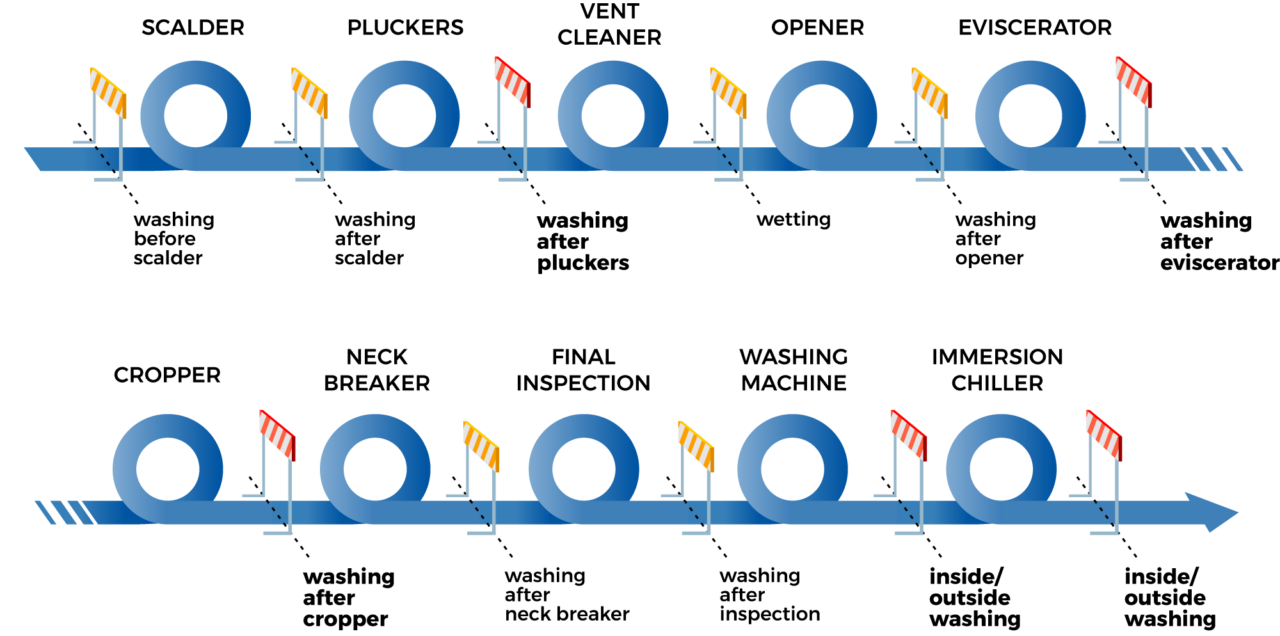Variation in flock size causes hygienic problems
| Twan Koenen |
Solved with the Undine® Hurdle Concept
A client of ours in the Netherlands, a poultry processing plant, faced issues with significant variation in their flock supply. The variation was twofold: in the size and weight of the chickens and in their condition. At times, the client received “standard” chickens, approximately 2.5 kg each, with empty crops. The client had calibrated their processing machines accordingly, resulting in manageable rejections. However, there were occasions when much heavier chickens with full crops were delivered, leading to problems. The error rate of the OEM processing machines increased from 2% to 5% per machine, culminating in a total failure rate exceeding 10%.
Additionally, the existing washers failed to clean the chickens adequately. The immediate reaction was to increase the water pressure in the OEM washers to attempt to clean the chickens, which only resulted in higher water consumption without solving the issue. The chickens remained dirty, leading to rejections and fines imposed by veterinary inspectors. In Europe, such fines also mandate a 35% reduction in line speed, costing the client substantial amounts of money.
EU legislation
The inspection system in Europe is based on 100% visually clean products, which can only be washed with potable water. Salmonella inspections are stringent and involve neck skin samples. Contamination with intestinal contents, feces, and feathers leads to rejections, as these harbor most pathogens. Removing these contaminants effectively also eliminates the majority of pathogens.
The client had no control over their processing due to the unpredictable supply quality. They felt at the mercy of their product deliveries and unable to make necessary adjustments in practice.
The solution
Our solution is the Undine® hurdle concept. This concept addresses contamination as it occurs or becomes accessible. In this case, the Undine® hurdle concept is implemented as follows:

- Undine® washer placed after the plucker (PL011)
This washer takes advantage of the open follicles post-plucking, a window lasting about 10 to 15 seconds. During scalding, plucking fingers introduce contaminants into these open follicles. Undine® microdroplets can remove contaminants from deep within the follicles of the chicken skin. Once the follicles close, contaminants become inaccessible and can resurface later, such as during the production of ground chicken. Therefore, it is crucial to remove contaminants from follicles at this specific point. - Undine® washer placed after electro stimulation (PL011)
This washer cleans the carcass exterior to mitigate cross-contamination risk since all chickens come into contact with the same machine parts. - Undine® washer placed after the vent cutter (PL014a)
This outside washer immediately removes fecal matter released during evisceration, preventing it from adhering to the carcass. This station also keeps the carcass moist during transport to the next processing stage. - Undine® washer in the eviscerator (PL022a)
A manifold with 3 Undine® mixing chambers prevents contamination by bile if the gallbladder is damaged. Bile contamination is It rejection criterion by veterinary inspectors. - Undine® washer inside the cropper and outside washer after cropper (PL024)
Undine® Manifolds inside the Cropper. It consists of 2 manifolds with mixing chambers in the cropper, cleaning the carcass interior and removing feed residues. Followed by an Undine® outside washer. - Undine® washer inside FIM
Manifold for ‘backflushing’ in the lung remover, cleaning the carcass interior. An additional Undine® manifold cleans the exterior, washing away remaining organ residues. - Finally, a complete Undine® inside-outside washer (PL029) at the end of the processing line
This washer addresses any remaining contaminants after the preceding steps.
Advantages
A notable feature of the Undine® hurdle concept at this client is the water and air supply system, which is connected to a loop dedicated solely to the Undine® washers. A single frequency-controlled water pump regulates the water supply. This allows the client to adjust the cleaning power of the Undine® washers centrally. When processing difficult batches of heavy chickens with full crops, the client can set the water pump on maximum capacity, ensuring clean chickens without issues from the veterinary service. For standard, well fasted flocks, the client can lower the pump capacity and water volume, still achieving clean chickens.
Water saving
The client operates a high-speed line with a capacity of 13,500 chickens per hour. At max. capacity, the water consumption in the processing department is 1 liter per chicken. At reduced capacity, the consumption reduces to 0.6 liters per chicken. Before implementing Undine®, the water consumption was 2.3 liters per chicken, with chickens not meeting the 100% visual cleanliness standard. With a water saving of up to 60%, the chickens are now 100% visually clean. For this client, the significant water savings are an added benefit. The primary advantage is now having control over the product quality.
Less energy consumption and maintenance
The client also saves on wastewater, energy, and maintenance because Undine® operates contactless, leading to minimal wear. Contactless operation also eliminates the risk of cross-contamination from Undine® equipment.
Overall, the savings make the investment in the complete Undine® hurdle concept — comprising all washers — pay off in less than 12 months. This does not even account for the quantified quality improvements.
 +31 (0) 527 745 932
+31 (0) 527 745 932 info@iwc-international.com
info@iwc-international.com

